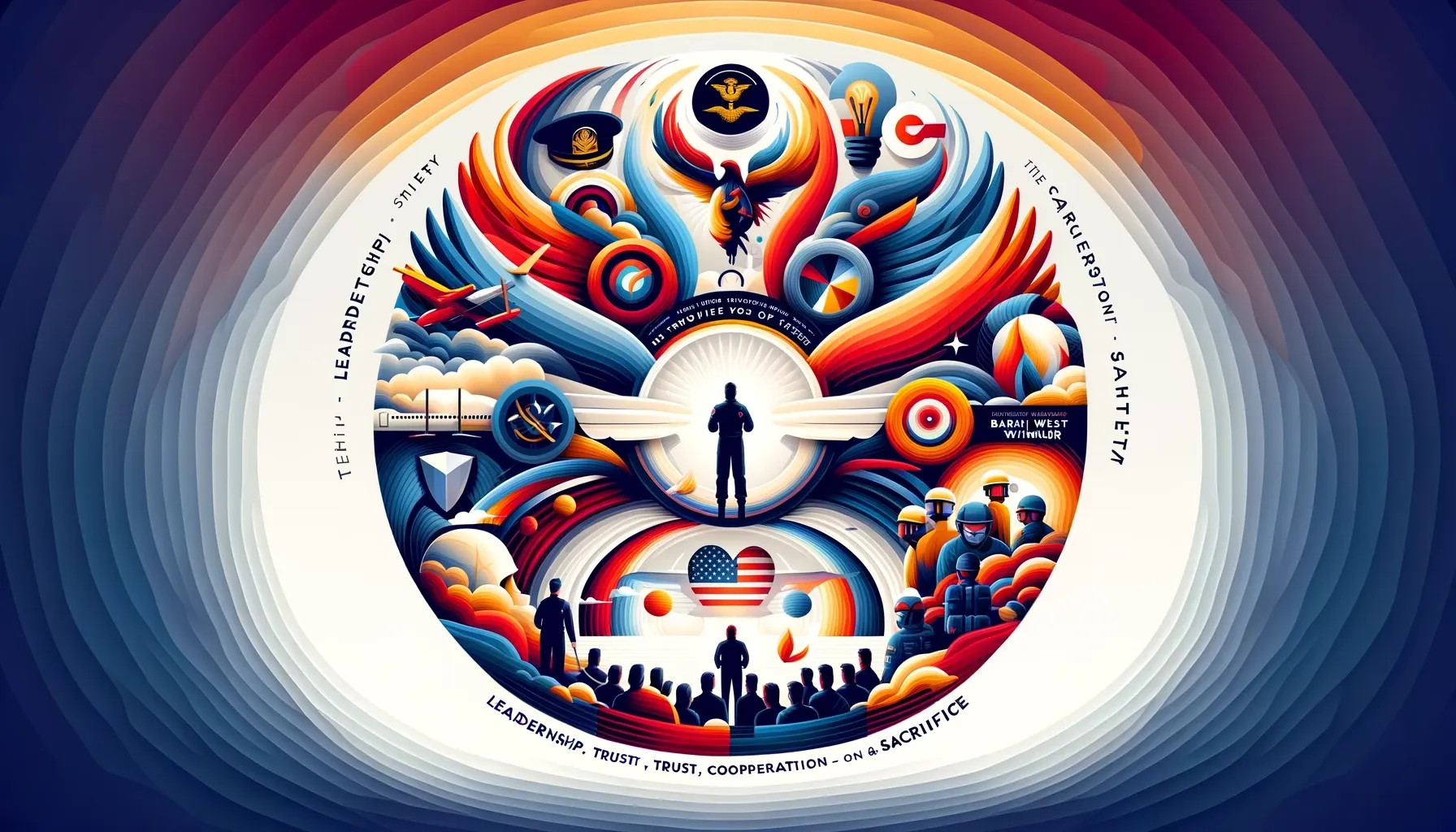On this page
Simon Sinek's TED talk discusses leadership, trust, cooperation, and sacrifice. It begins with the heroic story of Captain William Swenson and his act of bravery during an ambush in Afghanistan, serving as an introduction to the concept of selflessness and sacrifice. The speaker then explores these themes in various contexts, including the business world, early human societies, and the military. The 'circle of safety' is introduced as a key concept, highlighting the role of trust within a group or organization. Several real-world examples, such as Southwest Airlines, Next Jump, and Barry-Wehmiller, are used to illustrate these principles in action. The speaker emphasizes that leadership is a choice, not a rank, and draws parallels between good leadership and good parenting. The content concludes with a discussion on the role of a leader, the concept of servant leadership, and the reciprocity of sacrifice.
How does it apply to you?
The lessons from this talk can be applied in any leadership scenario, whether in a school project team, a sports team, or within a corporate setting. Understanding the importance of creating a 'circle of safety' and fostering trust and cooperation can help leaders inspire their teams and achieve remarkable outcomes.
Applied Learning to Developer Enablement
In a development team, trust and cooperation are vital. These feelings can be fostered by creating a 'circle of safety' within the team, where every member feels secure and valued.
Leadership also plays a crucial role in a software development team. A good leader prioritizes the well-being of the team and fosters a sense of trust and cooperation. This can lead to remarkable outcomes, such as high-quality software and efficient development processes.
The concept of 'questioning authority' can be applied in a software development context as well. In a healthy development team, members should feel safe to question decisions and suggest improvements. This contributes to a culture of continuous learning and improvement.
The example of Southwest Airlines shows how a positive workplace environment, where employees don't fear their leaders, can lead to success. Similarly, in a software development organization, a positive culture can lead to higher productivity and better software.
The comparison of leadership to parenthood can be applied to software development as well. A good leader, like a good parent, provides opportunities, education, and discipline to help the team grow and achieve more.
The lifetime employment policy at Next Jump can be an inspiration for software development organizations. Instead of firing employees for performance issues, they can provide support and coaching to help them improve.
The criticisms of banking CEOs for sacrificing their employees to protect their own interests can serve as a warning for leaders in software development. Leaders should prioritize the well-being of their team and the quality of the software over their own personal gains.
The story of Barry-Wehmiller's response to the recession shows how good leadership can foster trust and cooperation even in hard times. Similarly, in a software development organization, good leadership can help the team navigate challenges and come out stronger.
The concept of leadership as a choice, not a rank, can be applied to software development as well. Even junior developers can show leadership by taking responsibility and looking after their teammates.
The Marine custom of officers eating last underlines the concept of servant leadership, which can be applied in a software development context. Leaders should put the needs of their team before their own.
Finally, the role of a leader as defined in this context - someone who takes risks before anyone else and prioritizes the safety, protection, and advancement of their people - is highly relevant in software development. Leaders in this field often need to take risks, such as adopting new technologies or methodologies, and they should always prioritize the well-being of their team.
Developer Checklist
Creating a Positive Work Environment
Fostering Team Growth and Well-being
Leadership Practices
Summary
Story of Captain William Swenson
Captain William Swenson was awarded the Congressional Medal of Honor for his actions on September 8, 2009. During an ambush in Afghanistan, he ran into live fire to rescue the wounded and pull out the dead. One of the people he rescued was a sergeant who had received a gunshot to the neck. The rescue was captured on a GoPro camera by a medic.
Reflections on Heroism and Sacrifice
The speaker reflects on the deep emotion and love that it takes for someone like Captain Swenson to risk his life for others. He contrasts this with the business world, where people often get rewarded for sacrificing others for their own gain. He concludes that it's not that people in the military are inherently better, but that the environment can bring out remarkable qualities in anyone.
Concepts of Trust and Cooperation
Trust and cooperation are key to such acts of heroism. These are feelings, not instructions, and they come from a sense of safety and belonging. The speaker discusses how these concepts originated from early human societies where dangers were prevalent, and trust and cooperation within a tribe were essential for survival.
The Circle of Safety
The speaker introduces the concept of a 'circle of safety' - a sense of security and trust within a group or organization. This concept is drawn from early human societies where trust within a tribe was essential for survival. In a modern context, this circle of safety can help organizations thrive amidst external challenges and threats.
The Role of Leadership
Leadership plays a crucial role in creating the right conditions inside an organization. A leader who prioritizes the safety and well-being of their team can foster a sense of trust and cooperation. This, in turn, can lead to remarkable outcomes.
Questioning Authority and Fear in the Workplace
The speaker questions an authority figure, asking why they can't treat individuals as humans rather than cattle. The authority figure's response reveals a fear of retribution and a lack of trust in their leaders. This exchange sets the stage for a deeper discussion on workplace culture, particularly in organizations where employees don't feel safe or trusted by their superiors.
Southwest Airlines as a Model of Trust
Southwest Airlines is highlighted as a model where employees don't fear their leaders, leading to a more positive workplace environment. The speaker argues that when employees feel safe, they are more likely to collaborate and contribute to the organization's success.
Leadership Compared to Parenthood
The speaker draws a parallel between great leadership and good parenting. Both involve providing opportunities, education, and discipline when necessary to help others grow and achieve more than they could on their own.
Lifetime Employment Policy at Next Jump
Next Jump, a tech company in New York, is highlighted for its policy of lifetime employment, where employees cannot be fired for performance issues. Instead, they are given support and coaching, much like a parent would do for their child. This approach contrasts with companies that lay off employees in hard times.
Violation of Leadership Principles by Banking CEOs
The speaker criticizes banking CEOs for their disproportionate salaries and bonuses, arguing that the issue isn't the numbers, but the violation of leadership principles. These CEOs are viewed as having sacrificed their employees to protect their own interests.
Leadership in Crisis: Barry-Wehmiller's Response to Recession
During the 2008 recession, manufacturing company Barry-Wehmiller was hit hard and needed to save money. Instead of laying off employees, the company implemented a furlough program, demonstrating that all employees mattered. This decision fostered trust and cooperation among employees.
Leadership as a Choice, Not a Rank
The speaker emphasizes that leadership is a choice and not tied to one's rank within an organization. Good leaders are those who choose to look after those around them, regardless of their position within the company.
Marine Custom of Officers Eating Last
A story about Marines, where the officer eats last, is used to underline the concept of servant leadership. The practice of putting others' needs before one's own is presented as a key characteristic of true leadership.
The Role of a Leader
A leader, as defined in this context, is an individual who steps forward first, taking risks before anyone else. The term 'leader' is applied to them because they prioritize the safety, protection, and advancement of their people, even if it necessitates personal sacrifice.
The Reciprocity of Sacrifice
When leaders choose to put their people first and make sacrifices for their benefit, it elicits a natural response of reciprocation. People are willing to give their utmost effort, even to the point of blood, sweat, and tears, to realize their leader's vision.
Mutual Loyalty
The reasoning behind such sacrifice and dedication from the team is the belief that their leader would do the same for them. This mutual loyalty creates the foundation for a desirable and effective organization.
Conclusion
The speaker concludes by reiterating the importance of this mutual sacrifice and loyalty in creating an organization that everyone would want to be a part of. The audience shows their appreciation with applause.
FAQs
What heroic actions did Captain William Swenson carry out on September 8, 2009? Captain William Swenson ran into live fire to rescue the wounded and pull out the dead during an ambush in Afghanistan. One of the people he rescued was a sergeant who had received a gunshot to the neck.
What is the 'circle of safety' concept? The 'circle of safety' is a sense of security and trust within a group or organization. This concept originated from early human societies where trust within a tribe was essential for survival. In a modern context, this circle can help organizations thrive amidst external challenges and threats.
What role does leadership play in organizations? Leadership plays a crucial role in creating the right conditions inside an organization. A leader who prioritizes the safety and well-being of their team can foster a sense of trust and cooperation. This, in turn, can lead to remarkable outcomes.
How is Southwest Airlines a model of trust? Southwest Airlines is highlighted as a model where employees don't fear their leaders, leading to a more positive workplace environment. When employees feel safe, they are more likely to collaborate and contribute to the organization's success.
How does Next Jump's policy of lifetime employment work? At Next Jump, a tech company in New York, employees cannot be fired for performance issues. Instead, they are given support and coaching, much like a parent would do for their child.
Why does the speaker criticize banking CEOs? The speaker criticizes banking CEOs for their disproportionate salaries and bonuses. The issue isn't the numbers, but the violation of leadership principles. These CEOs are viewed as having sacrificed their employees to protect their own interests.
How did Barry-Wehmiller respond to the 2008 recession? During the 2008 recession, Barry-Wehmiller implemented a furlough program instead of laying off employees. This decision fostered trust and cooperation among employees.
What is the speaker's view on the concept of leadership? The speaker emphasizes that leadership is a choice and not tied to one's rank within an organization. Good leaders are those who choose to look after those around them, regardless of their position within the company.
What is the Marine custom of officers eating last about? The Marine custom of officers eating last underlines the concept of servant leadership. The practice of putting others' needs before one's own is presented as a key characteristic of true leadership.
How is a leader defined in this context? A leader, in this context, is an individual who steps forward first, taking risks before anyone else. They are called 'leaders' because they prioritize the safety, protection, and advancement of their people, even if it necessitates personal sacrifice.
What elicits a natural response of reciprocation in people? When leaders put their people first and make sacrifices for their benefit, it elicits a natural response of reciprocation.
What does mutual loyalty create? Mutual loyalty creates the foundation for a desirable and effective organization.
What is the importance of mutual sacrifice and loyalty in an organization? The importance of mutual sacrifice and loyalty in an organization is that it creates an organization that everyone would want to be a part of.
Glossary
Circle of Safety: A sense of security and trust within a group or organization, drawn from early human societies where trust within a tribe was essential for survival. In a modern context, this circle of safety can help organizations thrive amidst external challenges and threats.
Lifetime Employment Policy: A policy where employees cannot be fired for performance issues. Instead, they are given support and coaching, promoting a sense of safety and trust within the organization.
Reciprocity of Sacrifice: When leaders choose to put the needs of their team before their own, it often leads to team members reciprocating the gesture, fostering a culture of mutual respect and cooperation.
Servant Leadership: The concept of putting others' needs before one's own. It is a key characteristic of true leadership.
Workplace Culture: The environment and attitudes within a workplace. A positive workplace culture is one where employees feel safe and trusted by their superiors.
Mutual Loyalty: The belief that their leader would do the same for them. This mutual loyalty creates the foundation for a desirable and effective organization.




